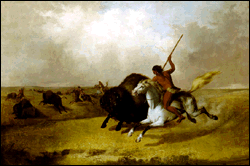JOSEPH HENRYPromoter of AnthropologyBy Marc RothenbergEditor, Joseph Henry Papers Project The creation of the National Museum of the American Indian is the most recent example of the Smithsonian Institution's commitment to the increase and diffusion of knowledge about Native Americans. It is a commitment which goes back to the first secretary, Joseph Henry. Among the major early studies in the human sciences (including linguistics, archaeology, ethnology, and physical anthropology) supported by the Smithsonian was the very first volume in the series Smithsonian Contributions to Knowledge, E. G. Squier and E. H. Davis's Ancient Monuments of the Mississippi Valley: Comprising the Results of Extensive Original Surveys and Explorations (1848). The series also included S. R. Riggs's Grammar and Dictionary of the Dakota Language (1852), Samuel F. Haven's Archaeology of the United States (1856), and Lewis Henry Morgan's Systems of Consanguinity and Affinity of the Human Family (1869). Although Henry was hesitant to have the Smithsonian become overly involved in either exhibition or collections, he made an exception for material dealing with Native Americans. In 1851, Henry issued a call for both the contents of ancient burial mounds and "the implements and industrial products of the present tribes of Indians." By 1875, he could boast that "nearly all the ethnological specimens have been transferred to the large room in the second story of the building and these present to the visitors of the Institution the most extensive collection of articles relative to the ethnology of the american Indians that has ever been exhibited."
The first major art exhibition in the Smithsonian consisted of Native American portraits by John Mix Stanley. They remained on display from 1852 until most of the paintings burned in the disastrous 1865 fire in the Smithsonian Building. In 1872, the cartoons or original sketches of George Catlin's portraits of Native Americans were exhibited. Henry had a number of motives for supporting research on Native Americans. First, such support demonstrated the breadth of the Smithsonian's interests. Henry's "Programme" envisioned science as more than physics and biology, and he wanted to emphasize this point. Second, there was great interest in the subject. In 1855 Henry reported that "the papers we have published in regard to it [ethnology] have been the most popular of any which we have given to the world." Third, he felt that the human sciences were not scientific enough. Speculation and policy too often took precedence over empirical research. Henry used the Smithsonian's financial resources and status to redefine the proper methodology for publications on anthropology. For example, he insisted to authors Squier and Davis that their monograph be "as free as possible from every thing of a speculative nature and that your positive addition to the sum of human knowledge should stand in bold relief unmingled with the labours of others." Henry later attacked the ethnology of George Robins Gliddon, accusing him of having misrepresented scientific facts so that he might attack religion. Henry described Gliddon's Types of Mankind (1854) as "in very bad taste" and contrasted Gliddon's approach to the relationship between science and religion with that of physiologists and geologists. The latter "are content to develope facts and to deduce, from them, principles, without a reference to their bearing on points of theology." For all his protests that "the subject of ethnology . . . is not one of my specialities," Henry did not hesitate to dictate to researchers on issues of style and content. Finally, Henry simply felt that understanding Native Americans was important. "Every thing relative to the manners customs habits and history of the aborigines of this country is of especial scientific interest, and this interest is at the present time much enhanced by the minute inquiries which have lately been instituted in almost every part of the world with regard to the peculiarities of the different races of men." Realizing the Smithsonian's resources were limited, Henry encouraged the federal government to support the human sciences before it was too late. In 1849, for example, Henry urged the Secretary of the Interior to continue financial support of the work of ethnologist Henry R. Schoolcraft: "The learned world looks to our country for a full account of the race that we have disposessed, and as every year renders the task more difficult, it is hoped that the investigations on the subject, now going on under the Government, will not only be continued, but that means may be afforded for their more active prosecution." Henry's patronage of the human sciences was very successful.
As one historian of anthropology concluded, "The Smithsonian
Institution dominated American anthropology from its founding in
1846 until the emergence of university departments after the turn
of the century." Henry demonstrated that by committing the
Smithsonian's resources and prestige, the institution could
influence the direction and research questions of a scientific
discipline.
Public Servant || Educator || Promoter of Anthropology || Scientist & Christian || Readings Henry Home || IHD Home || Smithsonian Institution Archives Home |
